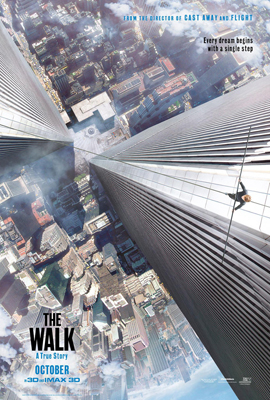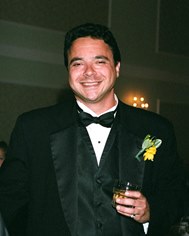 I found myself surprisingly moved by the overall message of “The Walk,” Hollywood’s retelling of the “incredible true story” of Philippe Petit’s high wire walk across the 140-foot span between New York City’s World Trade Center towers on Aug. 6, 1974. Rising above cliché and avoiding disastrous results like Petit himself, director Robert Zemeckis manages to craft a modern-day fairy tale using amazing special effects to tell the story of Petit’s absolutely true and incredible feat.
I found myself surprisingly moved by the overall message of “The Walk,” Hollywood’s retelling of the “incredible true story” of Philippe Petit’s high wire walk across the 140-foot span between New York City’s World Trade Center towers on Aug. 6, 1974. Rising above cliché and avoiding disastrous results like Petit himself, director Robert Zemeckis manages to craft a modern-day fairy tale using amazing special effects to tell the story of Petit’s absolutely true and incredible feat.
Like walking on a wire itself, “The Walk” could have fallen from lofty heights. For one thing, if you want the best account of the amazing events of Philippe Petit’s story, you go to the source- 2008’s documentary “Man On Wire” with Petit himself telling his story. Despite showing actual filmed footage of his fantastical high wire walk, it was Petit’s genuine passion for embarking on this death-defying act and his view of it as a life-affirming mission that made “Wire” fascinating. Conveying Petit’s rationale and capturing his buoyant spirit is what I thought would be toughest to translate into a major studio movie, but Zemeckis succeeds in doing just that. In the smart casting of Joseph Gordon-Levitt as Petit, Gordon-Levitt avoids pitfalls himself; in the unenviable position of popping blue contacts into his eyes and adopting a French accent, his performance overcomes these obvious obstacles and manages to capture Petit’s passion. Having seen Gordon-Levitt recreate Donald O’Connor’s “Make ‘Em Laugh” routine from “Singin’ in the Rain” (complete with running up a wall and doing a back flip live on television) during his hosting of “Saturday Night Live,” I knew he had the goods- his lean frame and physical dexterity make him completely believable in the role of Petit.
Like “Man On Wire,” Zemeckis smartly has Petit (Gordon-Levitt) narrate his own story in “The Walk”- it’s also the smart tactic that Zemeckis used to great success in his 1994 film “Forrest Gump” and yields the same effective results. Also like “Gump,” Zemeckis deftly grounds “Walk’s” fantastical story into a fable. As Petit recounts his story of being a Parisian street performer who, by chance, sets his eyes upon the construction of the World Trade Center and sees his “calling” to walk the wire across the Twin Towers, the mechanics of a plan are set into motion. While others view this plan to rig a steel wire across the Twin Towers as impossible and a “death wish,” Petit sees it as just the opposite. If belief can make the impossible possible, Petit views the wire walk as a “coup”- its successful completion being the very definition of what it means to be alive.
To accomplish his wire walk, Petit enlists the help of various people. For planning the stunt, he looks to famed Parisian circus owner Papa Rudy (Ben Kingsley) to ensure the safe technical foundation for rigging the wire and attain the knowledge that only a learned wirewalker can impart. Through the help of his girlfriend and fellow street performer Annie (Charlotte Le Bon) and photography student Jean-Louis (Clement Sibony), he gains further accomplices in Paris and New York to hatch his scheme. To gain access to the nearly-completed upper floors of the Twin Towers, Petit and his small crew pose as construction workers to set up this illegal stunt. The events and setbacks inherent in Petit’s plan unfold nicely and are plotted well by Zemeckis; they have all the feel of a caper done with Hitchcockian suspense.
But it’s the wire walk itself that’s the star of “The Walk.” Even though it’s only in the last half-hour of the film, the build-up to the event doesn’t disappoint. I was able to see this in 3D and recommend seeing it this way as the visual effects astonish. Whether it’s the wind blowing wispy clouds between the Twin Towers or watching birds fly above Manhattan traffic from a 110-story high vantage point, the CGI effects from Petit’s perspective is an unimaginable rush. Regardless of having a height phobia or knowing the outcome of Petit’s endeavor, your palms will sweat (as mine did) walking tenuously in Petit’s slippered shoes.
Truth may be stranger than fiction, but Zemeckis gives “The Walk” something extra- he shows the transformative power in achieving the impossible. While Petit’s plan to accomplish his “coup” may have seemed insane, its successful completion transcended scrutiny to become sublime. His act allowed New Yorkers who once viewed the World Trade Center as an eyesore (resembling “filing cabinets”) to now see the Twin Towers in a whole new light- the Towers became beacons of hope. After the events of 9/11, the movie captures all of the poignancy in this bittersweet viewpoint.
However cliché you view incredible true stories to be, Petit’s story through Zemeckis’ eyes creates a life-affirming message of hope. In this regard, “The Walk,” like its World Trade Center centerpiece, is a towering achievement.
